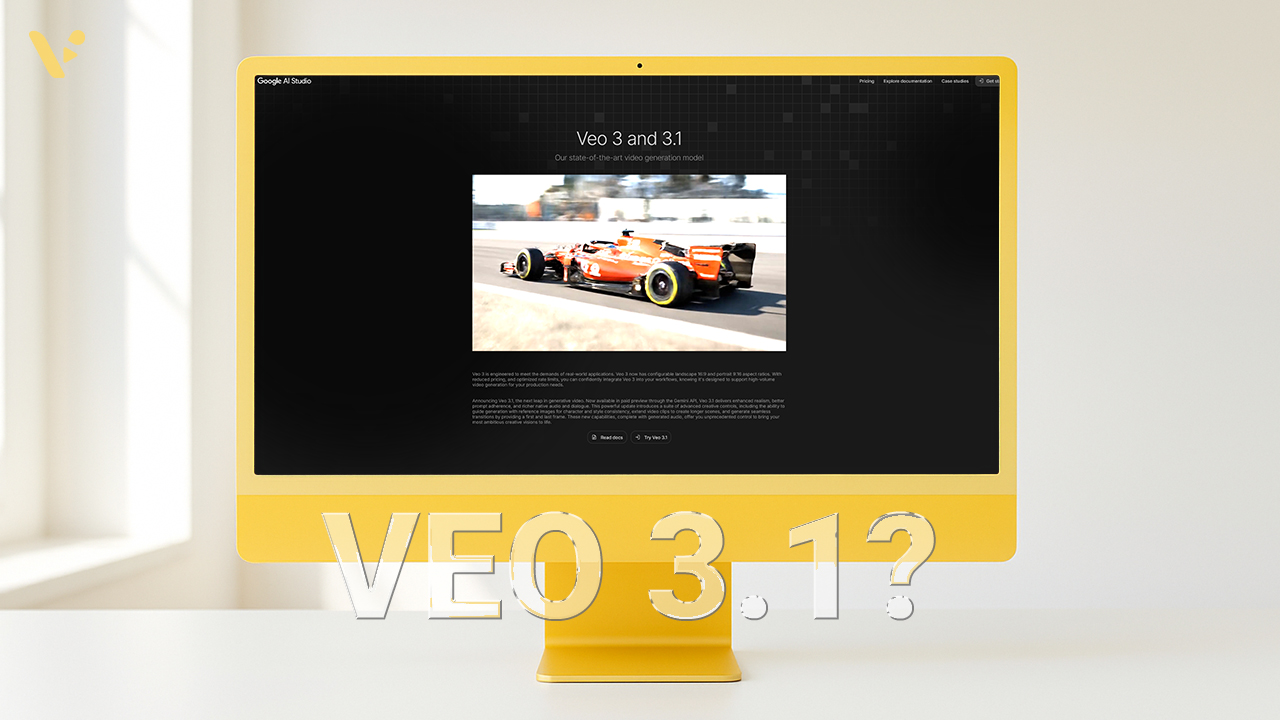Quick Answer: What is Veo 3.1?
Veo 3.1 is Google’s latest video generation model. It creates short video clips from text or images, now with native audio and new controls that help you maintain continuity between shots. You can generate a clip, extend it, and keep characters, lighting, and camera style consistent. You can also guide the look with up to three reference images and shape transitions using first‑ and last‑frame prompts.
The basics about Veo 3.1
You don’t need a film crew to make short, on‑brand video anymore. Google’s Veo 3.1 release adds better realism, clear control tools, and native audio that moves with the scene. You can build shots from text, steer style with reference images, extend clips into longer sequences, and edit objects right inside Flow. If you lead video for marketing, training, or product, this update lowers the time from idea to finished cut.
How is Veo 3.1 different from Veo 3?
Veo 3.1 focuses on control and realism. You get:
- Native audio that includes spoken lines, ambience, and sound effects when you ask for them in the prompt.
- Multi‑image guidance so you can lock in a character, wardrobe, or product design across shots.
- First/last‑frame control so the model knows exactly how a shot should start and end.
- Extend to continue a Veo‑made clip into a longer sequence, then stitch those sequences into a full edit.
- Flow editing tools like Insert to place an object into the scene with lighting and shadows that match. Remove rolls out next, which makes quick clean‑ups easy.
In short, Veo 3.1 gives you more ways to direct the scene and fewer reasons to fix things by hand later.
How is Veo 3 different from Veo 2?
Veo 3 made a clear jump in image quality and prompt following over Veo 2. It added 1080p landscape output, support for vertical 9:16, and a faster, lower‑cost Fast tier for high‑volume workflows. It also improved physics, camera movement, and text‑to‑video detail so scenes looked less synthetic and more cinematic. Veo 3.1 builds on that base with continuity tools and audio.
When did Veo 3.1 launch?
Google introduced Veo 3.1 on October 15, 2025. It’s available in the Gemini app, in Flow for hands‑on editing, and in the Gemini API and Vertex AI for developers. Google also offers Veo 3.1 Fast for speed‑sensitive jobs.
What can you do with Veo 3.1?
Veo 3.1 helps you move from script or storyboard to watchable video faster. The model generates 4, 6, or 8‑second clips at 24 fps in 720p or 1080p. You can stack those shots into a full piece, or you can extend a Veo clip to build longer scenes. You can keep a hero character consistent, match lighting across shots, and add or remove objects in Flow.
Here’s the simple version of what you can do with Veo 3.1:
- Text to video. Describe the scene, the camera, and the mood. Veo turns your words into a moving shot with matching audio.
- Image to video. Upload one or more reference images and ask Veo to animate that subject or style.
- Extend a Veo clip. Keep the action going by lengthening a clip and keeping continuity.
- Edit in Flow. Insert an object with realistic lighting and shadows. Remove undesired items as the rollout completes.
- Export at 720p or 1080p. Deliver landscape 16:9 or vertical 9:16 for social, learning portals, or product pages.
The best practices for writing prompts for Veo 3.1
Good prompts read like a director’s notes. Use this five‑part structure and you’ll get predictable results:
- Cinematography: camera type, lens, movement, and composition.
- Subject: who or what the shot focuses on, with a concise description.
- Action: what happens, in one or two sentences.
- Context: location, time, weather, and lighting.
- Style & ambiance: color palette, mood, soundtrack cues, and any dialogue.
Example
“Cinematography: 35mm handheld medium shot, slow push‑in. Subject: a delivery robot with a friendly LED face. Action: it rolls through an office lobby and stops to greet a receptionist. Context: golden hour light through glass, soft reflections on marble. Style & ambiance: warm colors, soft piano, light crowd chatter, robot says ‘Package for Amelia.’”
Tips that help every time
- Write dialogue in quotes so Veo knows what to say.
- Call out SFX and ambience in plain language: “light wind, street noise, soft footsteps.”
- Use negative prompts to avoid unwanted items: “no logos, no text overlays, no extra people.”
- Name the character and reuse that name across clips to anchor identity.
- Lock continuity with reference images when wardrobe, product finishes, or brand assets matter.
- Keep each prompt short. If you need multiple beats, use timestamps or create separate shots and assemble them in your editor.
How does Veo 3.1 handle copyrighted material?
Veo 3.1 embeds watermarking with SynthID at the frame level, and the Gemini app adds a visible indicator. Google also runs safety checks to reduce the risk of replicating protected content. You should still follow best practices. Avoid using unlicensed images as references, don’t ask for brand names you don’t own, and keep legal review in the loop for public campaigns.
Can businesses use Veo 3.1?
Yes. The Gemini app supports creative teams that want quick clips. Flow supports editors who need to fix or polish scenes. The Gemini API and Vertex AI support engineers who want to automate or scale production.
Here’s the direct answer: if your company uses video for ads, product explainers, onboarding, or learning, you can use Veo 3.1 today. Your team can prototype shots in the Gemini app, refine them in Flow, and integrate Veo 3.1 into your internal tools through the API. If you manage lots of assets, you’ll like the Fast tier for speed and cost control.
The quality of Veo 3.1 videos
Veo 3.1 produces sharper frames, cleaner motion, and better lighting than earlier versions. It keeps subjects on model when you anchor with reference images. Audio follows the scene and avoids awkward gaps when you define ambience and dialogue. You still need a human eye for pacing, story, and brand timing, but the raw shot quality now meets common marketing and learning needs.
Do people want to see Veo 3.1 videos?
Viewers care about clarity and story. If a video explains a product, shows a workflow, or tells a short story, they’ll watch it. Veo 3.1 helps you make that content quickly, and the native audio keeps the experience cohesive. Use the tool to create B‑roll, product vignettes, and micro‑stories that support your message. Keep the cut lean, add burned‑in captions, and publish in the right aspect ratio for the channel.
You can use Veo 3.1 in Visla
You can build Veo 3.1 clips inside Visla. You can also choose Veo 3, Sora 2, and Sora 2 Plus for different looks and budgets. Visla handles generation, storage, and editing in the same place, so your team can collaborate faster.
How to create a Veo 3.1 clip in Visla
- Prompt
Open Visla and click Generate AI Video to open the prompt box. Pick Veo 3.1 as the model. Write what you want to see and hear clearly.
- Settings
Choose the duration up to 8 seconds per clip and the aspect ratio that fits your video project.
- Generate
Click Generate to create your clip. The clip saves to your Teamspace, so you can place it into any Visla project and collaborate with your team.
FAQ
Veo videos include a SynthID digital watermark. The Gemini app also adds a visible “AI‑generated” mark. You can verify the watermark with Google’s SynthID checker. You should disclose AI assistance according to your brand and jurisdiction.
Choose Veo 3.1 when you need the best fidelity, stronger prompt adherence, and the most reliable image‑to‑video continuity. Pick Veo 3.1 Fast when you need quick iterations, bulk output, or rough cuts that you’ll refine later. Treat Fast as your exploration mode and Standard as your production pass. Track costs by seconds generated and reserve Standard for your final selects.
Write dialogue in quotes and keep lines short. Call out ambience and sound effects in plain words, like light wind, soft footsteps, or city traffic. Ask for tone in your prompt, such as warm piano or subtle synth, then adjust music and voiceover levels in your editor. Keep audio simple during generation and polish the final mix after you lock picture.

